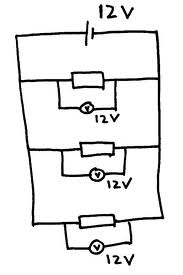I went back to your original thread, and I am wondering why you wired the LED's in series? I would have thought parallel.

LED DIY Project
Started by
Michael Wolfe
, Oct 13 2013 04:03 PM
27 replies to this topic
#21
 Guest_Irate Mormon_*
Guest_Irate Mormon_*
Posted 17 February 2014 - 11:19 AM
#22

Posted 17 February 2014 - 08:46 PM
gzeiger - no, I have not read anything about LEDs loosing intensity over their life span
Irate - the picture is hard to see, but they are actually wired in parallel (there was a jumper on the terminal block left two screws were black right two were red). You are right, they need to be wired in parallel.
Irate - the picture is hard to see, but they are actually wired in parallel (there was a jumper on the terminal block left two screws were black right two were red). You are right, they need to be wired in parallel.
Either write something worth reading or do something worth writing. - Benjamin Franklin
#23
 Guest_Usil_*
Guest_Usil_*
Posted 18 February 2014 - 03:15 PM
Wiring in parallel or in series depends on the voltage the LED requires and the voltage of the DIY transformer you might have available.


If your LEDs require 12 volts then the parallel circuit example is good. But if you don't have a 12 volt power supply in your junk DIY drawer and instead only had a 32 to 36 volt transformer then you would wire your three LED's in series to make sure each LED gets near 12 volts. You can drive LEDs with less voltage (a few less volts) but they will not have the full intensity. If they have a protective circuit built in they may flash off and on and get hot really fast if they receive voltage over their maximum rating.
The key is to provide a circuit that provides the proper voltage to the LEDs.
Usil


If your LEDs require 12 volts then the parallel circuit example is good. But if you don't have a 12 volt power supply in your junk DIY drawer and instead only had a 32 to 36 volt transformer then you would wire your three LED's in series to make sure each LED gets near 12 volts. You can drive LEDs with less voltage (a few less volts) but they will not have the full intensity. If they have a protective circuit built in they may flash off and on and get hot really fast if they receive voltage over their maximum rating.
The key is to provide a circuit that provides the proper voltage to the LEDs.
Usil
#24
 Guest_Irate Mormon_*
Guest_Irate Mormon_*
Posted 18 February 2014 - 10:24 PM
Gotcha - it would never occur to me to build or buy a power supply that was over voltage like that, but I do understand now. The LEDs act just like resistors. I am used to putting resistors in front of LEDs to keep them from burning up, so I never really thought of them that way. I have plenty of old computer power supplies, so 5 or 12V is not a problem. I could always cobble something together if needed.
#25

Posted 18 February 2014 - 10:30 PM
I wouldn't recommend doing them in series like that... I mean, yes it works in theory, but if one of those fails open then they all go off... and if one fails in a short, then the other get over voltage and potentially burn up?
I definitely did my four strands in parallel all at 12 volts using a purchased water resistant (rated) power supply.
I definitely did my four strands in parallel all at 12 volts using a purchased water resistant (rated) power supply.
Either write something worth reading or do something worth writing. - Benjamin Franklin
#26
 Guest_Irate Mormon_*
Guest_Irate Mormon_*
Posted 18 February 2014 - 10:40 PM
That's how I would do it, Michael. They are unlikely to short, but yeah, one could fail. I do need to upgrade my lighting - I am still using T12's, for pity's sake! That's the old timer in me. Plus I have a ton of ballasts lying around, and T12's are cheap. But now I want to do something different.
#27

Posted 18 February 2014 - 10:45 PM
That was me... I got tired of failed ballasts and/or failed fl.tubes... I even used these strip LEDs to replace the under cabinet lighting in our kitchen... well not these exact one, but the "warm" tone of the same product... and now I have a 24" fixture that had a tube fail... so I am going to do something to replace that one with LEDs now too.
Either write something worth reading or do something worth writing. - Benjamin Franklin
#28
 Guest_Usil_*
Guest_Usil_*
Posted 19 February 2014 - 01:27 PM
My example was just for use as an example when using what you might have around from other DIY projects. Reliability of LEDs pushes possible faults to the far future and they are pretty cheap to replace.
Usil
Usil
0 user(s) are reading this topic
0 members, 0 guests, 0 anonymous users








